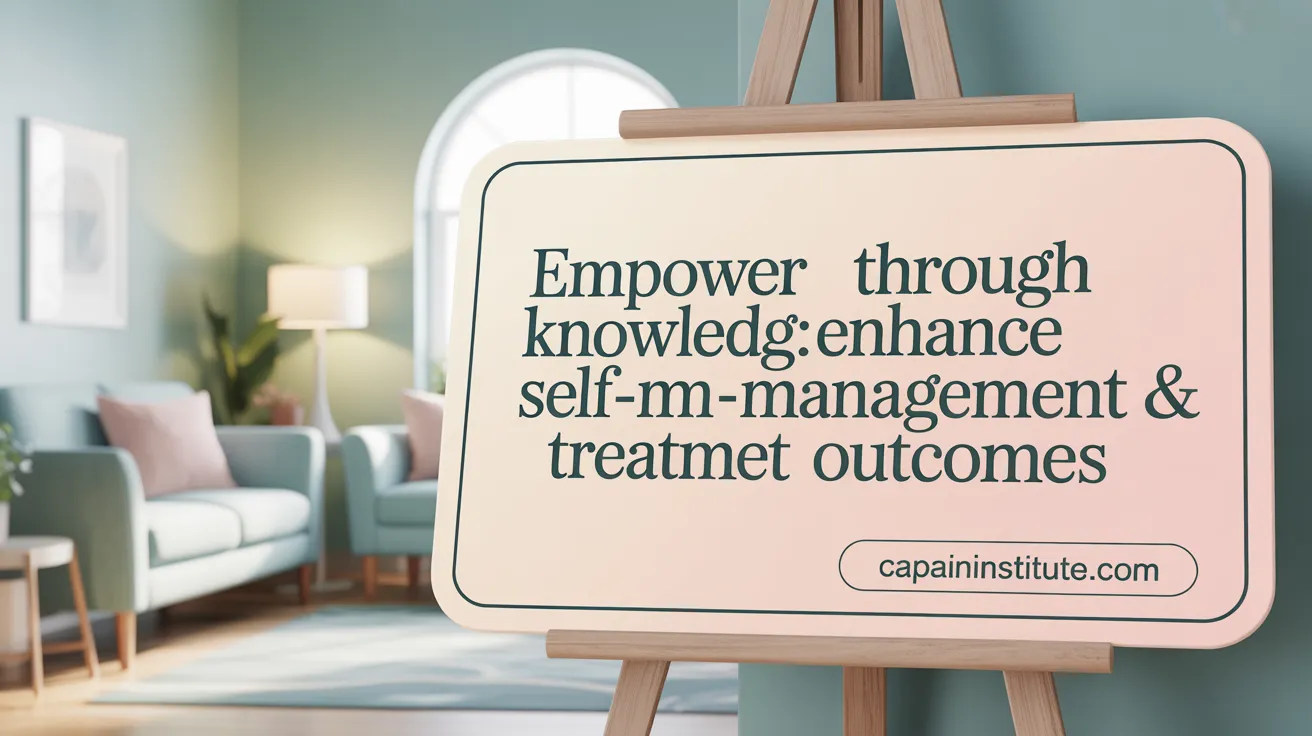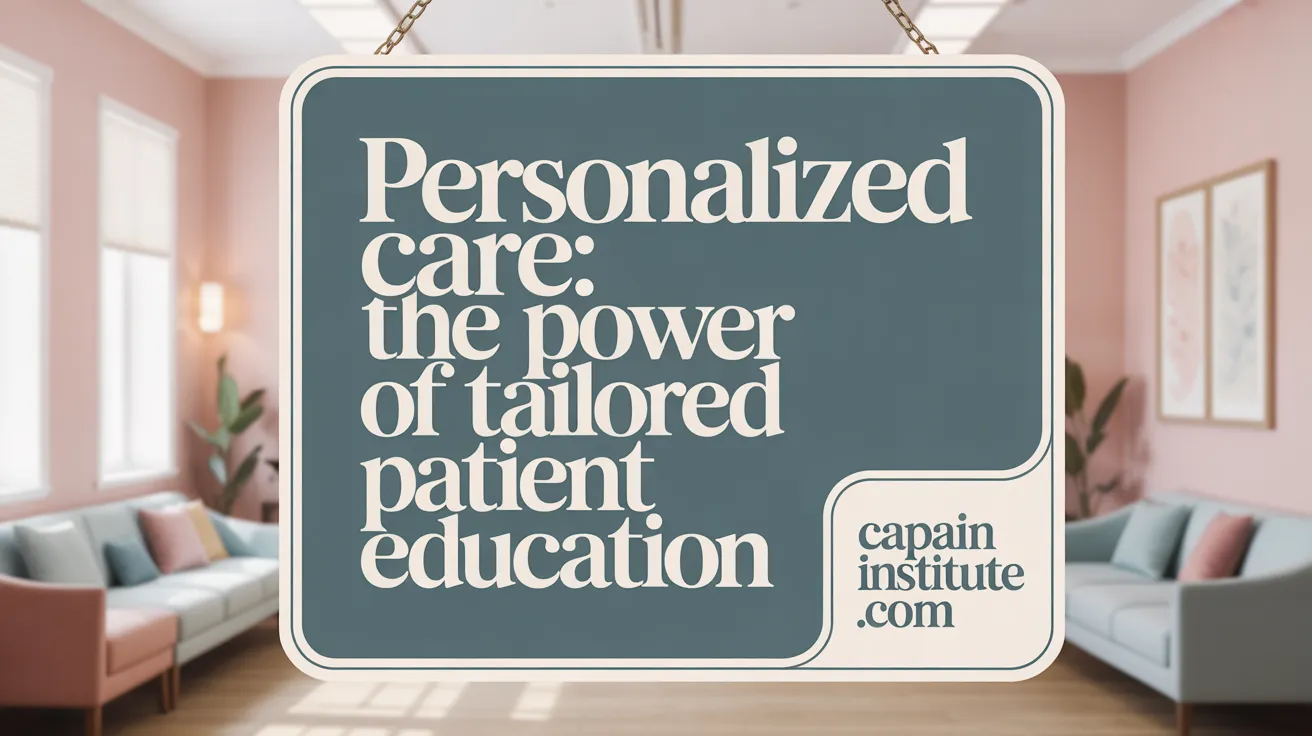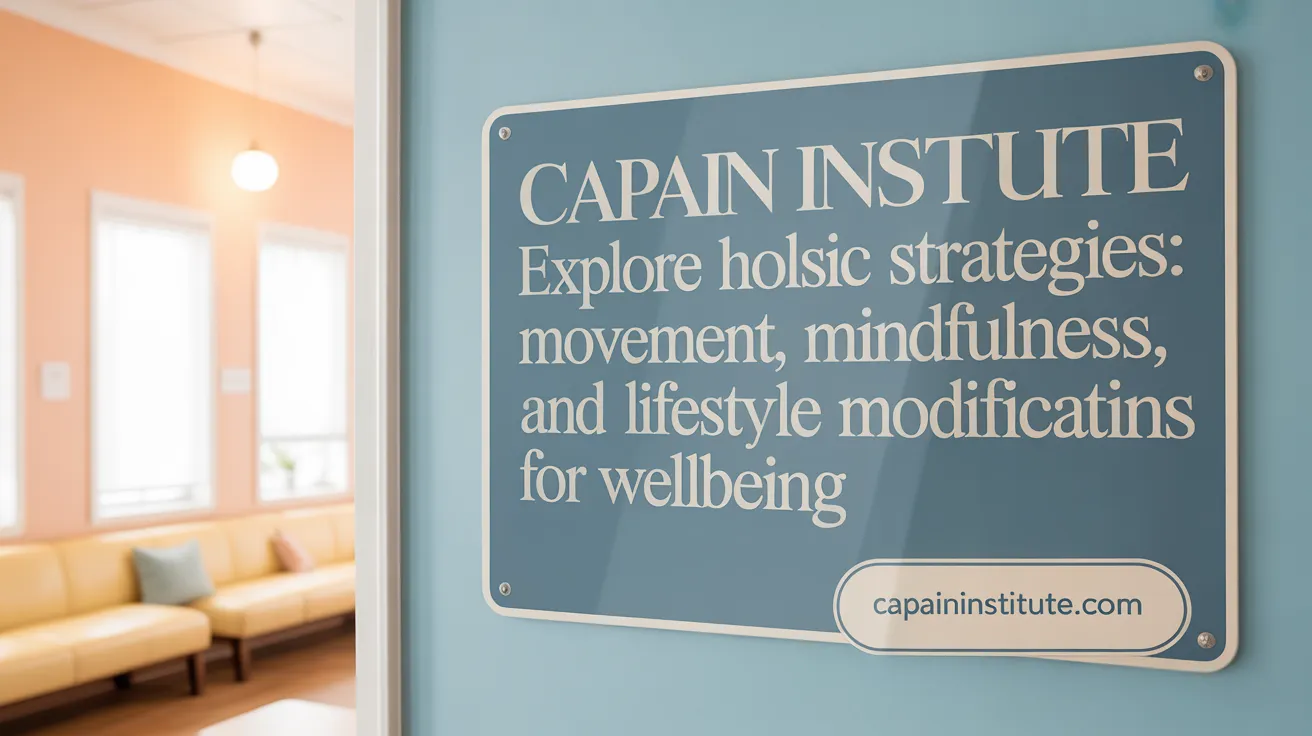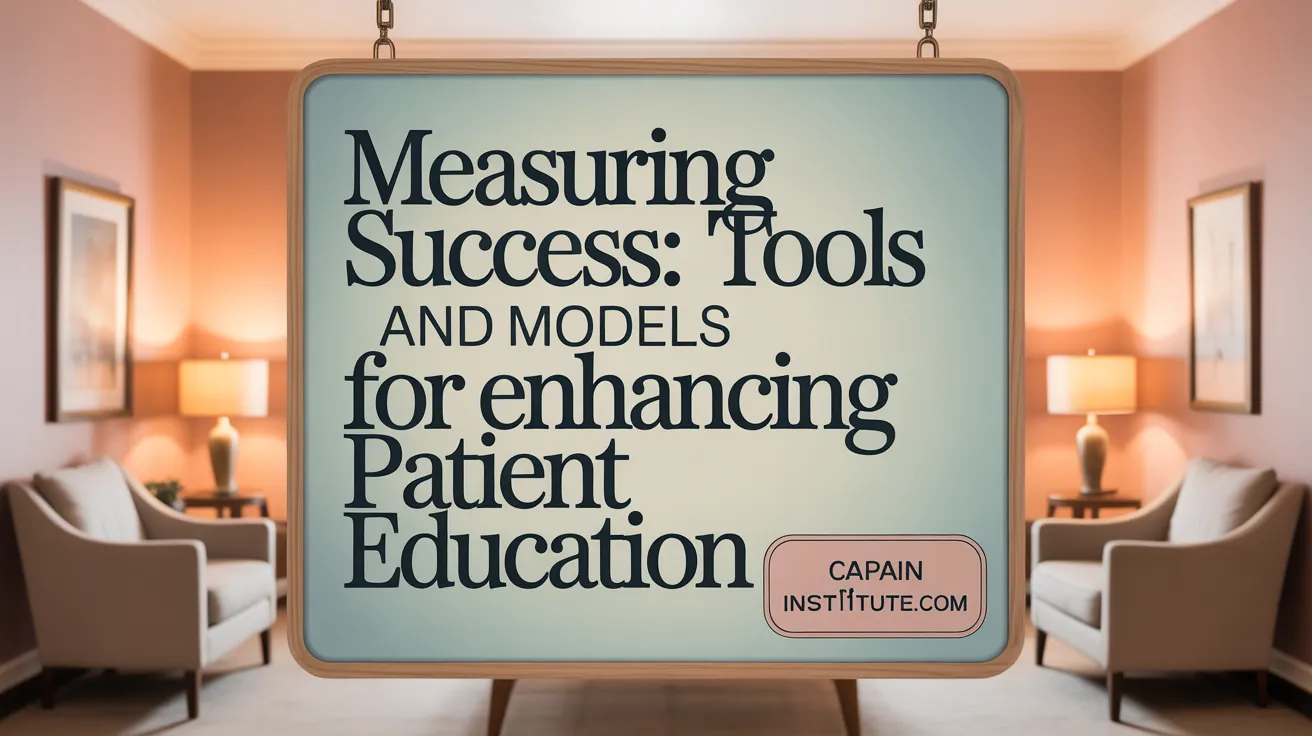Understanding the Critical Role of Education in Chronic Pain Care
Chronic pain affects millions worldwide, often leading to diminished quality of life and complex health challenges. As the understanding of pain’s multifaceted nature deepens, patient education emerges as a cornerstone for effective chronic pain management. Educating patients not only empowers them with knowledge but actively transforms their capacity to self-manage their condition, engage with healthcare providers, and improve overall outcomes. This article explores the vital importance of patient education in chronic pain treatment, outlining evidence-based strategies, the role of healthcare providers, and its impact on health and quality of life.
<!-- VIDEO:eyJsaW5rIjoiaHR0cHM6Ly93d3cueW91dHViZS5jb20vd2F0Y2g/dj02UkdQX3VzSWJCVSIsImltYWdlVXJsIjoiaHR0cHM6Ly9lbmNyeXB0ZWQtdGJuMC5nc3RhdGljLmNvbS9pbWFnZXM/cT10Ym46QU5kOUdjUzZUeHZ4ZnluWll2aU9DQ1hKSUpFaXRNVk80YXQ4Z3FGMVlTOWtSak13SHBRciZzIiwidGl0bGUiOiJQYWluIE5ldXJvc2NpZW5jZSBFZHVjYXRpb24iLCJzbmlwcGV0IjoiLi4uIHRyZWF0bWVudCBvZiBwZXJpcGhlcmFsIGFuZCBjZW50cmFsIG5vY2ljZXB0aXZlIGNvbXBvbmVudHMgd2l0aCBvdGhlciBjb250cmlidXRvcnMgb2YgcGFpbi4gQnV0IHdoYXQgaXMgcGFpbiBuZXVyb3NjaWVuY2UgZWR1Y2F0aW9uPyJ9 -->The Fundamental Importance of Patient Education in Chronic Pain Management
Empowerment through knowledge
Patient education is a cornerstone of effective chronic pain management. By understanding the nature of their condition, including the neurobiological mechanisms like brain plasticity and central sensitization, patients gain insight into why they experience pain. This knowledge demystifies their symptoms, diminishes fear, and encourages active participation in treatment.
Educated patients are better equipped to recognize triggers, implement self-management strategies, and make informed decisions about their care. They learn about various treatment options, including medications, physical therapies, and psychological approaches, which build confidence and foster self-efficacy.
Improved adherence and outcomes
When patients understand the rationale behind their treatment plans, including medication use, lifestyle changes, and non-pharmacological therapies, they tend to follow recommendations more consistently. Education on medication safety—covering dosage, side effects, and overdose risks—promotes responsible use and reduces adverse events.
Furthermore, awareness of holistic approaches such as exercise, mindfulness, and nutrition encourages adherence to multifaceted treatment plans. Evidence suggests that comprehensive education contributes to reductions in pain levels, disability, and healthcare utilization.
Building trust and communication
Clear, empathetic communication during education sessions helps build a trusting relationship between patients and healthcare providers. This rapport encourages open dialogue about fears, expectations, and concerns, which is crucial for tailoring individualized pain management strategies.
Involving patients in goal setting and decision making empowers them, making them feel valued and understood. As a result, patients are more likely to engage actively in their care, leading to better satisfaction and adherence.
Addressing medication fears and lifestyle modification
Many patients harbor fears about opioid addiction, side effects, and treatment costs. Targeted education regarding the benefits and risks of pain medications alleviates misconceptions and promotes safe usage.
In addition, education emphasizes the importance of lifestyle modifications such as physical activity, proper sleep, and stress management. Patients learn how these aspects influence pain perception and overall wellbeing, which can significantly improve long-term outcomes.
Reducing healthcare burden
Effective patient education can decrease unnecessary hospital visits, emergency department visits, and medication dependence by empowering individuals with self-management skills. Public education campaigns and structured programs increase overall awareness, leading to societal benefits such as reduced healthcare costs and improved quality of life.
In conclusion, patient education in chronic pain management is vital. It not only enhances individual health outcomes but also optimizes resource use within healthcare systems. When properly evaluated and integrated into practice, education fosters a proactive, informed, and engaged patient population, which is essential for sustainable pain management.
How Patient Education Enhances Pain Management Outcomes
How does patient education improve pain management outcomes?
Patient education plays a vital role in improving pain management by empowering individuals with essential knowledge about their condition. When patients understand the nature of their pain, the mechanisms involved, and the available treatment options, they become active participants in their care.
Educational initiatives inform patients about medication safety, correct usage, and potential side effects, which fosters adherence to prescribed therapies. This understanding helps reduce fears of addiction or adverse effects, making patients more willing to follow treatment plans.
Furthermore, comprehensive education encourages the use of lifestyle modifications such as regular physical activity, stress management, and sleep hygiene, thereby supporting symptom control.
Effective education also improves communication between patients and healthcare providers. Patients with clear expectations and understanding can better articulate their needs and concerns, leading to tailored interventions.
Building trust is another benefit of patient education. When individuals feel informed and supported, their confidence in the treatment process increases. This trust promotes adherence, enhances treatment satisfaction, and can lead to improved functional outcomes.
Overall, patient education is a cornerstone of successful pain management. It ensures that interventions are not only tailored to individual needs but also actively utilized, leading to safer, more effective, and holistic pain relief strategies.
Effective Strategies and Techniques for Patient Education in Chronic Pain Treatment
What strategies and techniques are effective for patient education in chronic pain treatment?
Effective patient education relies on clear and accessible communication tailored to each individual. Using simple language helps patients grasp complex concepts about pain, making education more impactful. Incorporating multimedia tools such as videos, animations, or interactive modules can enhance understanding and engagement.
Tailoring education to the patient's specific needs, preferences, and cultural background improves relevance and adherence. Personalizing information includes assessing individual barriers, beliefs, and learning styles, then customizing content accordingly.
A crucial component is teaching neurophysiology — explaining how the nervous system processes pain and potential misconceptions, such as degeneration being a disease requiring cure. Explaining concepts like neuroplasticity and reconceptualization can help patients reframe their understanding, reducing fear and catastrophization.
Behavioral approaches like Motivational Interviewing and goal setting frameworks like SMART (Specific, Measurable, Achievable, Relevant, Time-bound) foster patient activation and self-efficacy. These techniques support motivation and commitment to self-management strategies.
Providing comprehensive information on pharmacological treatments, including benefits, risks, and safe use of opioids and non-opioid medications, enables responsible medication management. Education should also include non-pharmacological approaches such as movement exercises, mindfulness practices, massage, acupuncture, and psychological therapies like Cognitive Behavioral Therapy (CBT).
Building trust through empathetic, transparent communication and establishing a collaborative relationship encourages patients to participate actively in their care. Explaining the importance of lifestyle modifications—such as proper nutrition, physical activity, and sleep hygiene—complements medical treatment.
Overall, combining these strategies enhances patient understanding, empowers self-management, and improves satisfaction and outcomes in chronic pain treatment.
| Strategy/Technique | Description | Benefits |
|---|---|---|
| Clear, simple language | Avoiding medical jargon for better understanding | Increased comprehension and adherence |
| Multimedia resources | Using videos, animations, apps | Enhances engagement and learning |
| Personalization | Tailoring info based on individual needs | Greater relevance and motivation |
| Neurophysiology education | Explaining pain mechanisms and reconceptualization | Reduces fear and catastrophizing |
| Behavioral techniques | Motivational interviewing, SMART goals | Boosts motivation and responsibility |
| Holistic information | Safe medication use, lifestyle, non-pharmacological treatments | Promotes comprehensive care |
| Empathetic communication | Building trust and partnership | Improves adherence and satisfaction |
Effective pain education combines clear, personalized messaging with behavioral and neurophysiological insights, supported by collaborative communication. This integrated approach fosters active patient participation, leading to better pain management outcomes.
Patient Knowledge, Communication, and Their Impact on Self-Management and Treatment Success

How does patient knowledge and communication impact self-management and treatment success in chronic pain?
Effective communication and proper education are vital components in managing chronic pain successfully. When healthcare professionals provide clear, tailored, and culturally sensitive information, patients are better equipped to understand their pain condition and participate actively in their care.
Tailored communication helps address individual patient needs, cultural backgrounds, and personal beliefs. This personalized approach fosters trust and engagement, making patients more receptive to self-management strategies.
Sharing knowledge about pain mechanisms, such as neuroplasticity and central sensitization, demystifies the condition, reducing fear and misconceptions. Patients who understand how their pain works are more likely to follow treatment plans and utilize self-management techniques like exercise, mindfulness, and pacing.
Using tools like PainAPP, a digital platform that provides personalized pain education, tracking, and goal setting, enhances engagement. Such technologies support continuous communication, motivate patients, and enable real-time adjustments to their management plans.
Shared decision-making, which involves discussing treatment options and setting realistic goals, boosts adherence and confidence. When patients actively participate in setting achievable milestones, they develop a sense of control and self-efficacy.
Addressing psychological and social factors through education can help manage emotional reactions, reduce catastrophizing, and improve overall well-being. Incorporating understanding of social support, stress, and coping mechanisms into patient education ensures a holistic approach.
Research shows that this collaborative model—combining effective communication, tailored education, and psychological support—leads to better pain management outcomes, improved quality of life, and sustained self-management practices.
In summary, fostering open, empathetic patient-provider communication and providing individualized education empower patients to take charge of their pain. This partnership enhances treatment adherence, reduces disability, and promotes long-term health improvements.
The Evidence Base Supporting Patient Education in Chronic Pain Management
What is the evidence supporting the value of patient education in chronic pain management?
Research consistently shows that patient education positively influences chronic pain outcomes, although the degree of benefit can vary. Studies indicate that education improves patients' understanding of their condition, modifies attitudes that may perpetuate chronic pain, and can lead to reductions in pain intensity and disability.
Assessment tools like knowledge questionnaires and attitudes surveys demonstrate increases in patient awareness and a shift toward healthier beliefs about pain. These educational interventions often enhance treatment adherence and patient satisfaction, contributing to a more active role in self-management.
Various outcome measures such as pain scores, functional assessments, and patient-reported satisfaction ratings are used to evaluate effectiveness. For example, a meta-analysis reveals that combined educational and physical therapy approaches lead to statistically significant reductions in pain, with improvements in function. There is also evidence that tailored education, which considers cultural, social, and individual factors, enhances relevancy and impact — especially among diverse populations such as Asian hospice patients.
The use of multimedia resources and digital tools—such as videos, apps, and virtual reality—has further improved understanding and engagement. These strategies provide accessible, personalized information that empowers patients to implement lifestyle changes, utilize appropriate medications safely, and adopt psychological techniques.
Integrating education with multidisciplinary pain management fosters better psychological wellbeing, enhances coping skills, and increases patient activation. Consequently, education is a crucial element within a comprehensive model, leading to better long-term outcomes, including reduced healthcare utilization and improved quality of life.
Significance of Tailored, Patient-Centered Educational Approaches

Why are tailored, patient-centered educational approaches significant in chronic pain management?
In chronic pain management, not all patients have the same learning needs, cultural backgrounds, or levels of health literacy. Customized educational strategies acknowledge these differences, making information more accessible and relevant. When healthcare providers assess a patient's background, beliefs, and understanding from the start, they can tailor education to meet specific needs.
Personalized education builds trust. Patients feel valued when their unique circumstances are considered, leading to better communication and openness. This trust encourages active participation in managing their pain.
Aligning treatment goals with patient's values and preferences is also crucial. When patients understand their options and influence decisions, they are more motivated and adhere better to prescribed plans. Such involvement fosters a sense of control, reducing anxiety and enhancing emotional wellbeing.
Furthermore, tailoring education supports not just physical health but also emotional and social wellbeing. It helps address psychological barriers like catastrophizing or fear-avoidance, which often impede effective management.
Overall, individualized, patient-centered education empowers people living with chronic pain. It promotes long-term engagement, improves clinical outcomes, and increases satisfaction. When patients are active partners in their care, they are more likely to adopt sustainable self-management strategies, leading to a better quality of life.
The Essential Role of Healthcare Providers in Delivering Effective Patient Education
What role do healthcare providers play in delivering effective patient education for chronic pain?
Healthcare providers are central to effective pain management through education. They start by conducting detailed assessments to understand each patient's unique experiences, beliefs, and needs regarding pain. This personalized evaluation helps tailor information and strategies to fit individual circumstances.
Clear, accurate communication is crucial. Providers must explain complex concepts such as pain neurobiology, the difference between acute and chronic pain, and how various treatments work. Delivering this information empathetically fosters trust and helps reduce fear and misconceptions.
Addressing misconceptions and stigma is another vital aspect. Patients often hold false beliefs about pain, medications, and the potential for dependence. Providers work to correct these misunderstandings while also reducing stigma related to pain conditions, which can improve treatment engagement.
Interprofessional collaboration enhances the quality of education. A team approach, involving physicians, nurses, physiotherapists, psychologists, and other specialists, ensures comprehensive care. Sharing expertise helps patients understand a broad range of management options, including medications, physical therapies, and psychological strategies.
Consistent provider training and ongoing education in pain management methods ensure that healthcare professionals stay updated. Well-informed providers are more confident and effective when educating patients, which translates into improved adherence and health outcomes.
Ultimately, healthcare providers empower patients by imparting knowledge about their pain condition. This education encourages active participation, self-management, and informed decision-making, all of which contribute to better long-term management of chronic pain.
Enhancing Patient Understanding of Pain Mechanisms and Management Strategies
How does patient education enhance understanding of pain mechanisms and management strategies?
Patient education plays a vital role in deepening the understanding of how pain functions. It helps clarify the complex biopsychosocial components involved in pain—namely, biological, psychological, and social factors—that shape the pain experience. Explaining these elements enables patients to reconceptualize their pain, especially by challenging common misconceptions such as the belief that degeneration is always a disease needing cure. Instead, education highlights that degeneration is a natural part of aging, not necessarily linked to harmful pathology.
Furthermore, quality education informs patients about various management strategies, including medication options—opioids and nonopioids—along with nonpharmacological therapies like movement exercises, mindfulness, and alternative treatments such as acupuncture or massage. This comprehensive approach empowers patients to participate actively in their care and make informed decisions.
Setting realistic expectations is another critical aspect. By understanding typical pain trajectories, patients can reduce anxiety about pain duration and intensity, which improves treatment adherence and outcomes. Additionally, education about the safe use of medications, disposal practices, and possible side effects enhances safety and confidence.
Effective clinician facilitation skills, such as active listening, empathetic communication, and collaborative goal setting, are essential to ensure that information is conveyed clearly. When healthcare providers foster trust and encourage patient engagement, education becomes more effective. Ultimately, thorough patient education leads to better pain management, higher satisfaction, and improved quality of life, as patients are equipped with the knowledge and skills necessary for safe and effective self-management.
Impact of Patient Education on Health Outcomes and Treatment Efficacy
How does patient education influence health outcomes and treatment efficacy in chronic pain?
Patient education significantly impacts health outcomes and treatment success in managing chronic pain. By providing individuals with a better understanding of their condition through biopsychosocial models, education enables patients to actively participate in their care and adopt effective self-management strategies.
Enhanced knowledge about pain neurobiology, treatment options, and lifestyle modifications leads to increased adherence to prescribed therapies and improved overall health. Engaging patients in their own care fosters greater self-efficacy—a person’s confidence in managing their symptoms—which is crucial for long-term control.
Involving patients and their partners in education sessions creates a more holistic, patient-centered approach. It helps address misconceptions, reduces fears such as addiction or side effects, and builds trust with healthcare providers.
Tailoring educational content to individual health literacy levels improves comprehension and practical application. Simple language, visual aids, and teach-back techniques can overcome barriers, making it easier for patients to implement pain management strategies.
Evidence from systematic reviews suggests that while patient education can moderately reduce long-term disability, its effects on short-term functional improvements or pain intensity are smaller. Therefore, education should be part of a comprehensive, multimodal treatment plan that includes physical therapies, psychological interventions, and pharmacological methods.
Overall, education enhances understanding of pain’s complex mechanisms, supports adherence to treatment, and boosts self-efficacy. These factors collectively contribute to better management outcomes, even if direct effects on immediate clinical symptoms are limited. Continued research is needed to clarify which educational strategies produce the most significant enhancements in treatment efficacy and quality of life.
Applying Educational Interventions to Improve Chronic Pain Treatment Practices
How can educational interventions be applied to improve chronic pain treatment practices?
Educational strategies play a vital role in optimizing how chronic pain is managed within healthcare. They help standardize communication between clinicians and patients, ensuring that information about pain conditions, treatment options, and self-management techniques is both clear and consistent.
Effective education encourages patients to actively participate in their care, fostering better adherence to medications, lifestyle modifications, and therapy plans. Multi-faceted delivery methods, such as face-to-face sessions, printed materials, multimedia content, and digital platforms, support diverse learning preferences and improve engagement.
Incorporating validated assessment tools like the Pain Management Effectiveness Assessment Tool (PMEAT) or the Patient Activation Measure (PAM) ensures that educational programs are personalized based on individual patient needs, barriers, and learning styles. These tools help clinicians identify knowledge gaps and tailor interventions accordingly.
The integration of digital tools and behavioral strategies, including mobile apps, virtual reality, and online interventions, makes pain education more accessible, especially for underserved populations. These innovations facilitate self-paced learning, reinforce behavioral techniques such as cognitive-behavioral therapy (CBT), and support ongoing self-management outside traditional clinical visits.
Supporting populations with limited access to healthcare—such as rural or socioeconomically disadvantaged groups—is a priority. Tailored outreach, community-based programs, and culturally sensitive materials ensure that vital pain education reaches all individuals.
Many successful initiatives combine these elements to enact lasting improvements. For example, standardized clinician-patient communication protocols, combined with multidisciplinary team training, improve consistency and quality of education. Overall, systematic, evidence-based educational efforts—delivered through both traditional and digital methods—are essential for elevating chronic pain management practices and enhancing patient health outcomes.
Integrating Non-Pharmacological Approaches in Patient Education

Movement exercises and physical therapy
Educating patients about movement and physical therapy options helps reduce pain and improve function. Techniques such as stretching, strengthening exercises, and low-impact aerobic activities promote physical health and mobility. Patients learn how to incorporate these strategies into daily routines, helping to decrease reliance on medications.
Mindfulness and cognitive behavioral therapy
Mindfulness and cognitive behavioral therapy (CBT) are psychological approaches that can significantly affect pain perception. Teaching patients mindfulness encourages present-moment awareness and stress reduction, while CBT helps reframe negative thoughts related to pain. Patients educated about these techniques can better manage emotional reactions and stress that often exacerbate pain.
Massage and acupuncture
Both massage therapy and acupuncture are complementary methods included in patient education programs. Explaining the benefits, safety, and proper use of these therapies empowers patients to adopt and adhere to alternative pain management strategies, fostering a more holistic approach.
Lifestyle modifications: nutrition, sleep, stress management
Patients benefit from understanding how lifestyle factors influence pain. Education on proper nutrition, adequate sleep hygiene, and stress management techniques helps control pain symptoms. These modifications can improve overall health, decrease inflammation, and enhance quality of life.
By integrating these non-pharmacological therapies into patient education, healthcare providers support comprehensive pain management. This approach encourages active participation and self-efficacy, ultimately leading to better long-term outcomes.
The Role of Patient Education in Medication Safety and Adherence
Understanding opioid and nonopioid medication benefits and risks
Educating patients about their pain medications is essential for safe and effective use. Patients should understand the benefits of opioids and nonopioid options, such as improved pain relief and improved function. At the same time, they need to be aware of potential risks, including side effects, dependency, and interactions with other drugs.
Safe medication storage and overdose recognition
Patients must be instructed on how to store medications securely to prevent misuse or accidental ingestion, particularly in households with children. Recognizing overdose symptoms, such as respiratory depression, blurred vision, or loss of consciousness, is critical. Providing clear guidelines on emergency actions can save lives.
Addressing fears of addiction and side effects
Many patients have concerns about addiction or adverse effects. Education can help dispel myths and clarify that, when used responsibly under medical supervision, the risk of addiction is minimized. Explaining side effects and how to manage or mitigate them encourages adherence without undue fear.
Facilitating responsible and effective medication use
Providing detailed instructions on correct dosages, timing, and potential interactions ensures medications are used responsibly. Patients should understand the importance of following healthcare provider instructions and the risks associated with non-compliance.
Effective patient education about medications enhances safety, encourages responsible use, and improves overall treatment outcomes. It supports patient empowerment and fosters trust between patients and healthcare providers.
Fostering Collaborative Patient-Provider Relationships Through Education

How does empowerment and patient activation play a role?
Empowering patients by providing comprehensive education helps them become active participants in their pain management. When patients understand their condition and learning self-management skills, they are more confident in making decisions and adhering to treatment plans. Activation encourages patients to take responsibility for their health, which can lead to better outcomes.
What is the role of motivational interviewing and behavior change techniques?
Healthcare professionals use motivational interviewing and behavior change strategies to facilitate meaningful conversations with patients. These techniques help explore patients' beliefs, address ambivalence toward change, and set achievable goals. This approach fosters trust and collaboration, motivating patients to commit to lifestyle modifications and self-management activities.
How does education address psychological and social barriers?
Patient education should include identifying and tackling psychological hurdles like fear, catastrophizing, and anxiety. Social barriers such as cultural beliefs or lack of support can also impede progress. Tailored education helps patients understand the biological aspects of pain and promotes positive attitudes, reducing emotional distress and social obstacles.
How does building self-efficacy enhance pain self-management?
How can healthcare professionals develop patients' confidence?
Building self-efficacy is vital in empowering patients to manage their pain effectively. This involves teaching problem-solving, modeling successful behaviors, and providing social support. Using tools like goal setting, positive feedback, and gradual skill development, healthcare providers can help patients feel more capable of managing pain independently, resulting in improved adherence and better quality of life.
| Topics | Strategies | Benefits |
|---|---|---|
| Empowerment & Activation | Patient education on self-management | Increased engagement and adherence |
| Motivational Techniques | Motivational interviewing | Enhanced motivation and trust |
| Psychological Barriers | Addressing fears, catastrophizing | Reduced emotional distress |
| Building Confidence | Goal setting, skill mastery | Greater self-efficacy and independence |
Effective education fosters a strong, collaborative relationship by making patients active partners in their care. This partnership supports sustained pain management and improved long-term health outcomes.
Evaluating Patient Education Impact: Tools and Measures

How is the effectiveness of patient education measured?
Assessing the impact of patient education in pain management involves various measurement tools. One common approach uses knowledge and attitude questionnaires, which evaluate whether patients understand their condition and hold positive beliefs about managing pain.
Concordance with treatment plans is another important indicator. When patients follow prescribed therapies and medication regimens, it suggests effective education. Patient satisfaction surveys also provide valuable insights, capturing how patients perceive the usefulness and clarity of information received.
In addition to these subjective measures, pain- and disability-related outcomes are measured to see if education translates into improved health. These include assessments of pain severity, functional ability, and quality of life.
Which models help evaluate the impact of pain education?
Healthcare professionals often use evaluation frameworks like Kirkpatrick’s and Moore’s models. Kirkpatrick’s model considers four levels: reaction (patient satisfaction), learning (knowledge gains), behavior (application of skills), and results (health outcomes). Moore’s model extends this to include additional stages of learning and behavior change.
These models provide a structured way to understand not just if education is well-received, but also if it results in meaningful changes in patient behavior and health.
Why is there a need for outcome-based assessments?
While current literature shows that most evaluations focus on patient satisfaction and knowledge, there’s a growing recognition of the importance of measuring actual patient outcomes. Improved pain control, reduced disability, better medication adherence, and enhanced quality of life are ultimate indicators of education success.
Focusing solely on satisfaction or knowledge might overlook whether education truly benefits patients in their daily lives. Therefore, future assessments should incorporate data on long-term health outcomes to provide a comprehensive picture of educational effectiveness.
Conclusion: Elevating Chronic Pain Care through Comprehensive Patient Education
Patient education stands as a transformative pillar in the management of chronic pain, equipping patients with essential knowledge, skills, and confidence to actively engage in their care. Through personalized, empathetic communication and evidence-based educational strategies, healthcare providers can enhance understanding of pain’s complex nature and promote effective self-management practices. While education alone may yield moderate improvements, its integration with multidisciplinary treatments amplifies benefits, fostering better adherence, functional outcomes, and quality of life. To maximize impact, ongoing evaluation and provider training must support scalable, tailored education programs. Ultimately, empowering patients through education not only improves pain outcomes but also reshapes the chronic pain care landscape toward more collaborative, patient-centered, and efficient healthcare.
References
- Evaluating the impact of pain education: how do we know ...
- Pain Management Education for Patients
- The Role of Patient Education in Effective Pain Management
- Self-Management of Chronic Pain: Psychologically Guided ...
- Helping Patients With Chronic Pain Through Education
- Treating Chronic Pain Starts With Patient Education
- Patient Education in Pain Management
